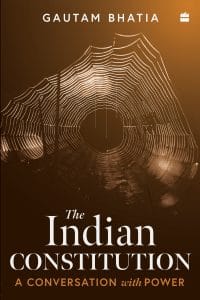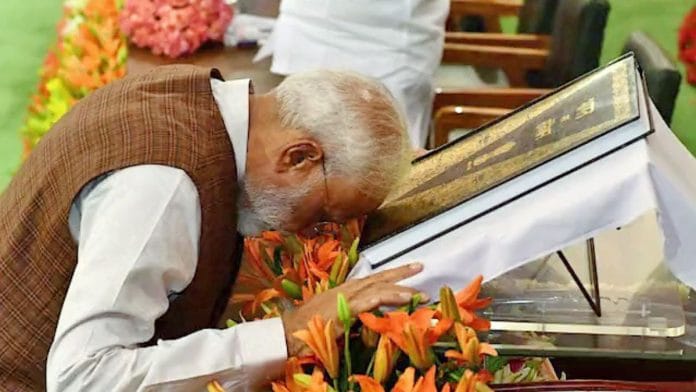MAY YOU LIVE IN interesting times’, is an invocation that, in popular folklore, is perceived more as a curse than a blessing. But whether curse or blessing, for anyone engaging with the Indian Constitution, the period 2019–24 was certainly an interesting time.
On 5 August 2019, soon after the general election returned the Bharatiya Janata Party (BJP) to power with an absolute majority for a second consecutive term, two Presidential Orders removed the constitutional autonomy (or ‘special status’) of the state of Jammu and Kashmir. A law followed, which converted the state into a centrally controlled union territory. These moves were immediately challenged at the Supreme Court, sparking a long-running legal battle about the nature of Indian federalism, the purposes of constitutional autonomy, the limits of Emergency rule, the powers of the Indian President, and much else.
Simultaneously, within the state, a months-long internet shutdown was imposed, while members of the (political) Opposition (along with many others) were subjected to administrative detention. These moves, too, were challenged before the Supreme Court, bringing the Constitution’s Fundamental Rights provisions into a clash with ‘reasons of State’.
While Jammu and Kashmir stands alone as the starkest example of a constitutional-political crisis involving federal relations, it was by no means the only one. In 2023, an eight-year-long dispute between the government of the National Capital Territory (NCT) of Delhi and the central government about the distribution of legislative and executive power seemed to have been finally resolved by the Supreme Court in favour of the former, only for Parliament to swiftly pass a law taking back the power that the Supreme Court had held it did not have. The next round of constitutional challenges awaits adjudication.
Meanwhile, in the same five-year period, three state governments under the rule of the Opposition were toppled through a series of manoeuvres involving legislators resigning or parties splitting. The beneficiary was the ruling party at the Centre (the BJP), which formed the new government in each case (sometimes with the ‘rebel’ legislators now within its own fold, and sometimes in alliance with one of the factions in the party split). Each of these cases ended up at the Supreme Court, where bitter disputes implicated the conduct of several constitutional functionaries: the centrally appointed state governors, the speakers of the Legislative Assemblies, and the Election Commission.
Nor was this the only time that the Election Commission found itself in the eye of the storm. In early 2023, a little over a year before the 2024 general election, the Supreme Court handed down a judgment depriving the executive of the power to appoint election commissioners, and (temporarily) vesting it in a committee comprising the Prime Minister, the leader of the Opposition, and the Chief Justice of India. By the end of the year, Parliament had passed a law that replaced the Chief Justice with a member of the Union cabinet, thus restoring the executive’s prerogative in selecting the composition of the Election Commission.
Also read: Savarkar wanted the Narasimha to be the symbol of Hindu Rashtra. ‘A cow is ghatiya’
A subsequent challenge to the law was put on ice by the Supreme Court. Thus, the 2024 general elections were contested under the auspices of an Election Commission where two out of three members had been effectively selected by the Prime Minister and a Union minister of his choice.
Constitutional conflict was not limited to states, political parties, and institutions. By the beginning of 2024, two abbreviations had entrenched themselves into national consciousness: ED, i.e., the Enforcement Directorate, and UAPA, i.e., the Unlawful Activities Prevention Act, 1967. The former is the body tasked with enforcing the provisions of India’s anti-money laundering law (the Prevention of Money Laundering Act, 2002 [PMLA]). The latter is India’s umbrella anti-terror legislation. What unite these two laws are their stringent bail provisions. These provisions appear to indicate a tolerance for, if not an active encouragement of, lengthy pre-trial incarceration. The frequent use of these laws saw a series of high-profile cases where members of the political Opposition arrested under PMLA and political dissidents arrested under UAPA approached the courts, challenging their arrests and seeking bail— with mixed success.
And if personal liberty often found itself at the bar of the judiciary, so did other kinds of clashes between individual, community, and the State. Challenges to home demolitions and evictions (which became endemic in 2021–23, often referred to as ‘bulldozer justice’), as well as to large-scale developmental projects that would result in displacement and environmental degradation were staple features in the courts’ constitutional docket.
Interesting times, indeed. But is there anything that connects these diverse struggles, other than the time period? After all, they involved very different actors, told very different stories, and involved very different parts of the Constitution.
On one popular account, these were all examples of constitutional hardball or, to invoke a more suitable metaphor, constitutional bodyline-bowling. As the term suggests, constitutional bodyline bowling refers to a constitutional actor (in this case, the central executive) testing just how far it can go under the limits established under the Constitution, and on occasion, even stretching or altering those limits. Constitutional bodyline-bowling would appear to be a natural consequence of the ebb and flow of politics, which from time to time results in a powerful and dominant central executive that enjoys a large legislative majority. Indeed, India is no stranger to constitutional bodyline-bowling. The regime of Indira Gandhi in the 1970—capped by the infamous Emergency—would appear to fit the bill just as well.
While there is something to say for this account of the constitutional battles during 2019–24, it remains limited in that it sees the examples cited above as separate and isolated instances. I believe, however, that there is something deeper that connects them, going beyond the actions of a particular dominant central executive. These instances all constitute interconnected strands within a web of power relations that is created and sustained by the Constitution.

This excerpt from ‘The Indian Constitution: A Conversation with Power’ by Gautam Bhatia has been published with permission from HarperCollins Publishers.






